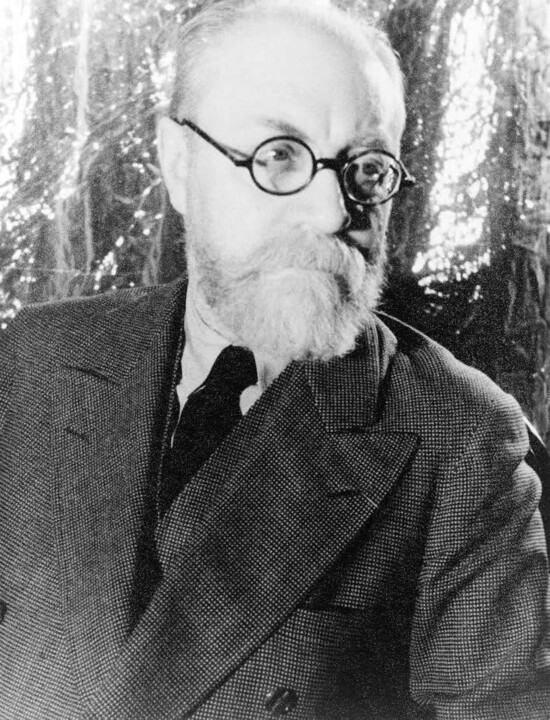 Henri Matisse photographed by Carl van Vechten
Henri Matisse photographed by Carl van Vechten
Henri Matisse was a world famous French artist, known for his work in painting, sculpture and modern art in general. Born in 1869 in Le Cateau-Cambrésis, Matisse began studying law before turning to art at the age of 21. He studied at the Académie Julian and later joined the École des Beaux-Arts in Paris, where he developed his unique style that would become emblematic of the Fauvist movement.
Matisse's style was characterized by the use of bright and intense colors, as well as simplified forms and strong outlines. He was influenced by Impressionist and Post-Impressionist artists, but he also developed his own technique of using color to create dynamic shapes and movement in his paintings.
Matisse is best known for his most famous works, including "La Danse", "La Femme au chapeau" and "Nu bleu". He also worked in the field of sculpture, creating pieces like "La Serpentine" and "La Nuit". During his lifetime, Matisse was considered a major innovator in the art world, having a profound influence on the artists of his time and on those who followed.
Matisse died in 1954 at the age of 84, but his artistic legacy continues today. His works are part of the permanent collections of many museums around the world, and his impact on modern art continues to be studied and celebrated. Henri Matisse will always remain one of the most influential and appreciated artists of his time.
Who was Henri Matisse?
 The facade of the family home of Henri Matisse's parents
The facade of the family home of Henri Matisse's parents
Son of a grain merchant, he grew up in a modest family. Despite this, his parents encouraged his creativity from an early age by giving him pencils and paper to draw on.
After obtaining his baccalaureate, Matisse began studying law in Paris. However, he quickly realized that his real passion was art. He therefore decided to pursue an artistic career and began attending the Académie Julian in Paris in 1891.
Under the guidance of renowned teachers such as William-Adolphe Bouguereau and Gustave Moreau, Matisse learned the traditional techniques of painting and drawing. However, he soon began to develop his own artistic style, influenced by Impressionists and Post-Impressionists such as Vincent van Gogh and Paul Cézanne.
In 1895 Matisse was admitted to the École des Beaux-Arts in Paris, where he continued to develop his unique style by working alongside other emerging artists such as André Derain and Maurice de Vlaminck. It was during this period that he began to experiment with bright colors and simplified forms, thus creating the beginnings of the Fauvist movement.
Although he was criticized by art conservatives for his innovative style, Matisse continued to follow his own artistic path, thus establishing his place in the history of modern art.
Early in his career, Matisse was influenced by Cézanne in particular. He was also inspired by African and Oceanic art, which was on display at the Musée du Trocadéro in Paris.
In 1896, Matisse took part in his first exhibition at the Salon of the Société Nationale des Beaux-Arts in Paris. He also exhibited at the Salon d'Automne in 1905, where his paintings were referred to as "fauve" due to their bold use of color.
In 1906 Matisse was invited by art dealer Ambroise Vollard to exhibit his works at the Galerie Vollard in Paris. This exhibition was followed by another important exhibition at the Galerie Bernheim-Jeune in 1907.
Henri Matisse had three children:
Marguerite Matisse, born in 1894, who became an artist and worked closely with her father.
Jean Matisse, born in 1899, who was a diplomat and worked as secretary of the French Embassy in London.
Pierre Matisse, born in 1900, who became a renowned art dealer in New York and founded Galerie Pierre in 1937. He represented many modern artists, including Joan Miró, Alberto Giacometti and Marc Chagall.
Henri Matisse had complex relationships with his children, especially with Marguerite who suffered from mental disorders. Despite this, his children left their mark on the world of art and culture, notably Pierre, who represented many modern artists and helped promote contemporary art in the United States.
Unfortunately, the relationship between Matisse and his children was often strained. Matisse was a demanding and perfectionist father, and he had high expectations for his children. Marguerite suffered from mental health issues throughout her life, which made their relationship even more difficult. Despite these difficulties, Matisse's children all left their mark on the art world, each in their own way.
Matisse and Fauvism
Fauvism is an artistic movement that emerged at the end of the 19th century and the beginning of the 20th century. It is a movement that was started by a group of artists, including Henri Matisse, André Derain and Maurice de Vlaminck.
Fauvism began to develop from around 1900, when Matisse and his colleagues began to experiment with color and light in their work. They used bright and intense colors to create effects of light and movement in their paintings.
The name "fauvisme" was given to the movement in 1905, after the group's first exhibition in Paris. Art critics were shocked by the use of bright, unnatural colors in the Fauves' works, and called their style "sauvage" ("fauve" in French).
Fauvism quickly grew in popularity, influencing other artists such as Georges Braque and Pablo Picasso. Although the movement was short-lived, it had a great influence on modern art and paved the way for other movements such as Cubism and Expressionism.
Henri Matisse became the leader of Fauvism because of his unique artistic vision and his major contribution to the movement. He played a key role in shaping the band's aesthetic ideas and shaping its artistic theory.
Matisse was the main representative of Fauvism from the very beginning, showing his works at group exhibitions of the group. His paintings have been noted for their bold and expressive use of color, as well as their simplified treatment of form. His famous canvas, "Joy of Life" has become one of the most iconic examples of the Fauvist style.
The Steins, a decisive encounter
 The Stein family
The Stein family
The meeting between Henri Matisse and Leo and Gertrude Stein was a defining event for the artist's career and for modern art as a whole.
In 1905, the Steins, who were art patrons and collectors of modern art, invited Matisse to their home in Paris to view his collection and introduce him to other emerging artists of the time.
Matisse was immediately impressed by the Steins' approach to art, which centered on creative freedom and personal expression rather than traditional artistic conventions.
Discussions with the Steins encouraged Matisse to break free from the constraints of academicism and explore new forms of artistic expression. He was also influenced by their collection of African and Oceanic art, which inspired his use of simplified forms and decorative patterns in his own works.
Meeting the Steins also led to Matisse being exhibited at Ambroise Vollard, an important art dealer of the time, who helped promote his work and bring it to a wider audience.
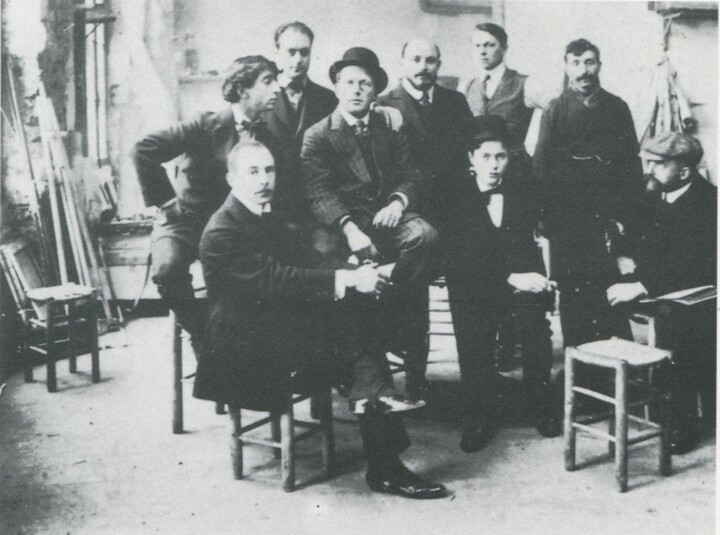 The Matisse Academy circa 1910. Far right: Wilhelm Straube. Far left: Walter A. Rosam. Seated right: Franz Nölken
The Matisse Academy circa 1910. Far right: Wilhelm Straube. Far left: Walter A. Rosam. Seated right: Franz Nölken
The Free Academy, with the help of Leo and Gertrude Stein. This art school was intended to provide students with an unconventional learning environment and a freer approach to teaching art.
The Free Academy was open to all interested students, regardless of age or previous training. Students were encouraged to express themselves freely and experiment with different artistic techniques, with the aim of developing their own style and artistic voice.
The philosophy of the Académie Libre was in line with the ideas of Matisse and the artistic theories he had developed over the years. Matisse encouraged students to focus on color, light, and simplified forms, rather than realistic representation.
The Académie Libre attracted many talented students, some of whom became major artists themselves, such as Jean Arp, Raoul Dufy and Albert Marquet.
The opening of the Académie Libre was an important event in the history of modern art, as it helped spread the ideas of Fauvism and encouraged a new generation of artists to explore more forms of expression. free and more personal.
The period of the First World War
The First World War had a significant impact on the life and career of Henri Matisse.
At the start of the war, Matisse was mobilized as a volunteer nurse and worked in a military hospital in Collioure. This experience deeply affected the artist, who was confronted with the suffering and death of wounded soldiers. He was also influenced by the atmosphere of the city, which had been transformed by the war.
After the war, Matisse experienced a period of change and personal reflection. He began to explore new subjects and new techniques, such as sculpture and woodcut. He also began to take an interest in the decorative arts and collaborated with craftsmen to produce works of art in fields such as tapestry and ceramics.
During this period, Matisse also developed his artistic style using simpler shapes and brighter colors, while avoiding dark subjects and images of war. This new approach was influenced by his experience as a volunteer nurse, as well as developments in modern art and art movements such as Cubism and Futurism.
Nice was a place of refuge for many artists and intellectuals during the war, as it was relatively spared from the fighting and offered a peaceful and inspiring environment. Matisse was immediately taken with the natural beauty of the region, with its vivid colors and picturesque landscapes. He began to explore the surroundings of Nice, painting landscapes, still lifes and portraits inspired by the region. During the war, Henri Matisse also had the opportunity to meet other artists in the city of Nice, including Auguste Renoir.
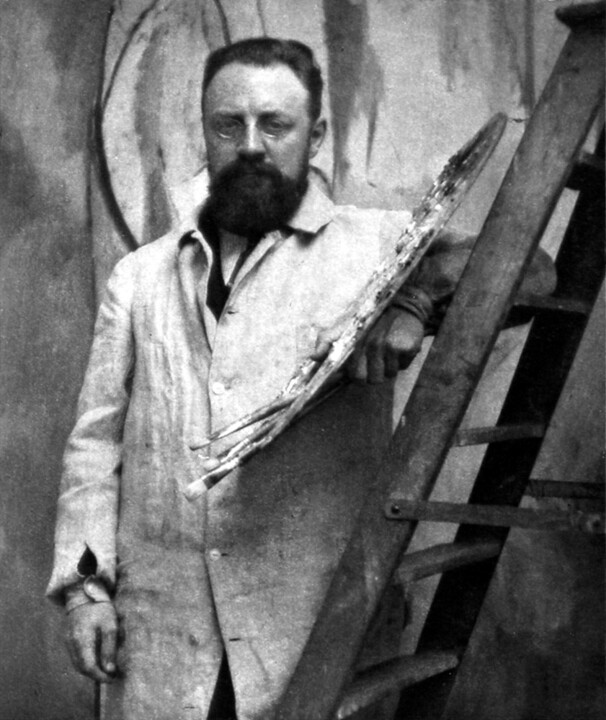 Henri Matisse in his studio in 1913
Henri Matisse in his studio in 1913
The Nice period
After the war ended, Matisse remained in Nice and continued to develop his art. The city had become an important cultural center, attracting many artists and intellectuals. Matisse was at the heart of this artistic community, befriending artists such as Pablo Picasso, Georges Braque and Fernand Léger.
Matisse also established a close relationship with the art dealer Ambroise Vollard, who organized several exhibitions of his work. Vollard was an influential art collector of the time, who had also worked with artists such as Paul Cézanne and Vincent van Gogh. His support contributed to the growing recognition of Matisse as an important artist.
During this period, Matisse also continued to experiment with different artistic techniques. He worked with woodcut, lithography and ceramics, and also continued to produce works of decorative art.
Despite his success and growing fame, Matisse remained humble and modest in his approach to art. He always sought to explore new ideas and techniques, and encouraged other artists to do the same.
The period of the Second World War
Henri Matisse lived the Second World War in France, where he witnessed the horrors of the Nazi occupation. During this period Matisse continued to work and produce art, but his artistic style was influenced by the events of the war.
In 1941 Matisse was diagnosed with cancer and underwent surgery which left him very weak. He was then forced to stay in bed for several months, which impacted his ability to create works of art. Despite this, Matisse continued to work, using techniques such as decoupage to create works of art.
During the war, Matisse was involved in the French resistance, and he worked with other artists to produce false papers and identity cards for people seeking to escape the Nazis. He was also active in the French artistic community, organizing exhibitions and events to promote arts and culture.
After the war, Matisse continued to work, producing some of his most famous works, including the Chapelle du Rosaire in Vence, southern France.
After the war
The last years of Henri Matisse's life were marked by a decline in his health and mobility. Despite this, he continued to create works of art and even experimented with new techniques.
In 1951, Matisse was asked to create stained glass windows for the Chapel of the Rose Garden in Vence, France. He created a series of drawings and cutout gouaches for the stained glass windows, which were installed in the chapel in 1952. These stained glass windows are considered some of Matisse's most remarkable works, combining his mastery of color and light.
Matisse died on November 3, 1954 at the age of 84. Despite his declining health, he continued to work until his death, leaving behind a rich and influential artistic legacy. Matisse's last works testify to his creativity and his passion for art, and continue to inspire the generations of artists who follow him.
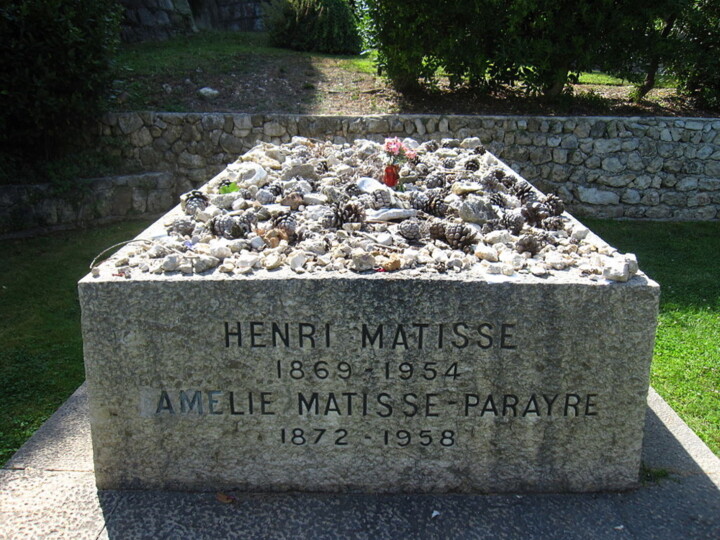 Tomb of Henri Matisse in Nice (France)
Tomb of Henri Matisse in Nice (France)
Matisse's other techniques
The sculpture
Henri Matisse became interested in sculpture towards the end of his artistic career, from the 1910s. It began with the creation of small objects in plaster and ceramics, which he used as models for his paintings.
In 1906 Matisse visited North Africa, where he was inspired by local arts and crafts, especially embroidered fabrics, pottery and jewelry. This experience influenced his artistic vision and contributed to his transition to sculpture.
Matisse experimented with different sculpting techniques including direct modelling, direct carving, and construction. He also worked with different materials, such as stone, bronze and plaster. Matisse created sculptures that were both abstract and figurative, often depicting female bodies or organic forms.
One of his most famous works is "La Danse", a bronze sculpture that depicts five intertwined figures in a rhythmic dance. This work was commissioned for the façade of the Musée d'art moderne de la Ville de Paris in 1931.
Despite his transition to sculpture, Matisse continued to produce paintings until the end of his life. The two mediums often influenced each other in his work, and his sculptures provided inspiration for his paintings, just as his paintings influenced his sculpture.
The cut papers
Paper cutouts became one of French artist Henri Matisse's most famous techniques. He began experimenting with this technique in the 1940s, after having surgery for cancer which left him very weak.
Cut-out papers are created by cutting shapes from colored sheets of paper and then gluing them to a flat surface to create an image. Matisse used this technique to create intricate and colorful works of art, which were praised for their beauty and simplicity.
At first, Matisse used this technique to create models for his murals and stained glass windows. But soon he began to create free-standing works of art, using this technique to create abstract compositions and portraits.
Matisse's cut-out papers were considered a revolution in the art world, as they expanded the possibilities of painting and inspired other artists to experiment with this technique. Matisse's artwork also influenced other art movements, such as abstract art and minimalism.
Some of Matisse's most famous works of art are his paper cut-outs, including "La Tristesse du Roi" and "La Gerbe". Matisse continued to work with this technique until the end of his life, creating works of art that were praised for their beauty, simplicity, and visual impact. Today, his paper cuts are considered some of the finest examples of 20th century art.
How did Matisse influence the art world?
Henri Matisse had a considerable influence on many artists, both in Europe and in the United States.
In Germany, Matisse influenced the expressionist movement, especially the German artist Ernst Ludwig Kirchner. Kirchner was fascinated by the way Matisse used color to create emotion and a sense of movement in his works, and he incorporated this approach into his own work.
In the United States, Matisse had an important influence on artists of the modernist movement, such as Jackson Pollock and Mark Rothko. Pollock was influenced by Matisse's cut-out paper technique, which he used to create abstract compositions. Rothko, on the other hand, was inspired by the way Matisse used color to create intense emotional effects.
Matisse also influenced other artists such as Pablo Picasso, who was a close friend of Matisse and with whom he collaborated on several artistic projects.
In short, Matisse had a considerable influence on many artists around the world, both through his innovative approach to color and form and through his technique of cut-out paper.
7 incongruous things to know about Matisse?
Henri Matisse was a very well known and respected artist, but there are some interesting and incongruous facts to know about him:
Matisse was passionate about dance and even created sets and costumes for ballet productions.
Matisse had a collection of over 300 African and Oceanian artworks, which he used as inspiration for his own work.
Matisse was known for his love of cats and had several throughout his life. He often included them in his works of art.
Matisse was asked to design the flag of New Caledonia in 1948, but he declined.
During World War II, Matisse was imprisoned by the Nazis for several months, after being suspected of resistance. He was released thanks to the intervention of friends and continued to work despite the difficulties.
Matisse loved to play chess and even used a chessboard in one of his artworks.
Matisse was also known for his love of cooking and even published a cookbook called "Henri Matisse: Drawings and Gouaches", which included illustrations of his own culinary creations.
These little-known facts show Matisse's diverse personality and varied interests, in addition to his remarkable artistic work.
Quotes from Henri Matisse
Here are some famous quotes from Henri Matisse:
"Creativity is often born out of confusion. Perhaps the great side of art is the ability to turn that confusion into clarity."
"There are flowers everywhere for anyone who wants to see them."
"I dream of making pure art, which would only be the expression of the beauty of human nature, of the mind and the heart."
"Accuracy is not truth."
"The important thing is not to copy but to create a new reality, the most beautiful there is."
"The color possesses me. It no longer needs me to exist."
"There are times when I don't know drawing yet, but I find it while working."
These quotes reflect Matisse's philosophy and creative approach to art and life.
The most famous works
Here are some of his most famous works:
"La Danse" (1909): An oil painting of nude figures in a circular dance pose, which became one of Matisse's most iconic works.
"La Femme au chapeau" (1905): A portrait of his wife, Amélie, in an extravagant hat, which was criticized at the time for its avant-garde style.
"Blue Nude II" (1952): An oil painting of a female nude in shades of bright blue and green.
"Goldfish" (1912): An oil painting of a bowl of goldfish, which became one of Matisse's most popular works.
"The Music" (1910): Another oil painting depicting nude figures in a dancing pose, but this time with musical instruments.
"Still Life with Oranges" (1899): An oil painting of oranges on a table, which shows Matisse's interest in still lifes.
"The Open Window" (1905): An oil painting depicting a view through a window, which shows Matisse's use of light and color to create atmosphere.
'Le Bonheur de vivre' (1905-06): A large oil painting of nude figures in a pastoral landscape, which was criticized for its lack of perspective but is now considered a major work of modern art .
"La Desserte rouge" (1908): An oil painting of a table set with fruit and glasses, which shows Matisse's use of color to create a vibrant mood.
"The Water Lilies" (1914-26): A series of oil paintings depicting the water lilies in his garden, which were made towards the end of his life and are considered one of his most important contributions to art. 'modern Art.

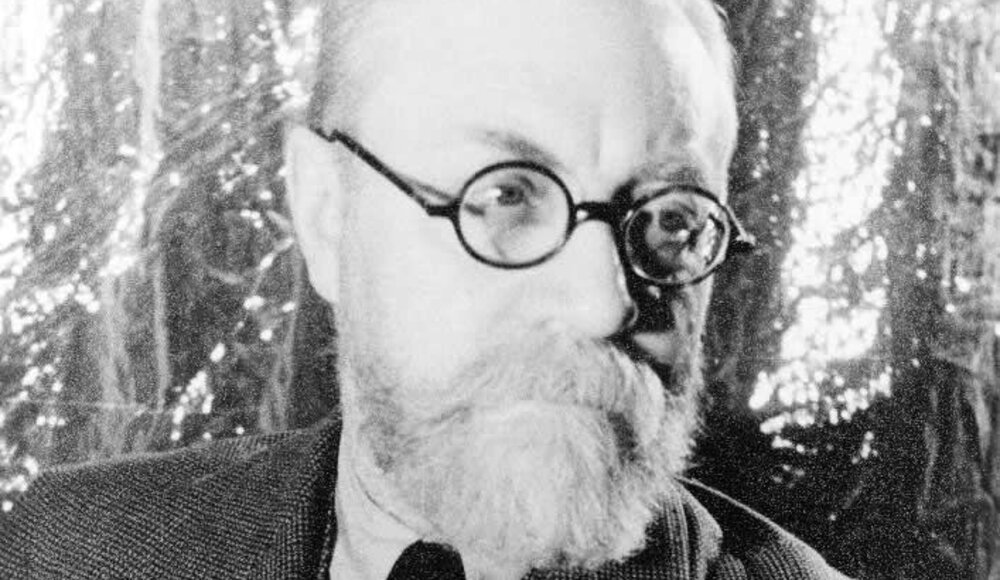
 Selena Mattei
Selena Mattei